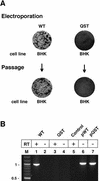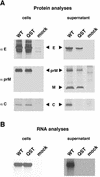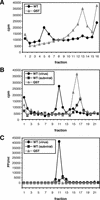Mutations in the yellow fever virus nonstructural protein NS2A selectively block production of infectious particles
- PMID: 11967294
- PMCID: PMC136122
- DOI: 10.1128/jvi.76.10.4773-4784.2002
Mutations in the yellow fever virus nonstructural protein NS2A selectively block production of infectious particles
Abstract
Little is known about the function of flavivirus nonstructural protein NS2A. Two forms of NS2A are found in yellow fever virus-infected cells. Full-length NS2A (224 amino acids) is the product of cleavage at the NS1/2A and NS2A/2B sites. NS2Aalpha, a C-terminally truncated form of 190 amino acids, results from partial cleavage by the viral NS2B-3 serine protease at the sequence QK /T within NS2A. Exchange of serine for lysine at this site (QKT-->QST) blocks the production of both NS2Aalpha and infectious virus. The present study reveals that this defect is not at the level of RNA replication. Despite normal structural region processing, infectious particles containing genome RNA and capsid protein were not released from cells transfected with the mutant RNA. Nevertheless, production of subviral prM/M- and E-containing particles was unimpaired. The NS2A defect could be complemented in trans by providing NS1-2A or NS1-2Aalpha. However, trans complementation was not observed when the C-terminal lysine of NS1-2Aalpha was replaced with serine. In addition to true reversions, NS2Aalpha cleavage site mutations could be suppressed by two classes of second-site changes. The first class consisted of insertions at the NS2Aalpha cleavage site that restored its basic character and cleavability. A second class of suppressors occurred in the NS3 helicase domain, in which NS3 aspartate 343 was replaced with an uncharged residue (either valine, alanine, or glycine). These mutations in NS3 restored infectious-virus production in the absence of cleavage at the mutant NS2Aalpha site. Taken together, our results reveal an unexpected role for NS2A and NS3 in the assembly and/or release of infectious flavivirus particles.
Figures








References
-
- Burke, D. S., and T. P. Monath. 2001. Flaviviruses, p. 1043-1125. In D. M. Knipe and P. M. Howley (ed.), Fields virology, fourth ed., vol. 1. Lippincott-Raven Publishers, Philadelphia, Pa.
Publication types
MeSH terms
Substances
Grants and funding
LinkOut - more resources
Full Text Sources
Other Literature Sources

